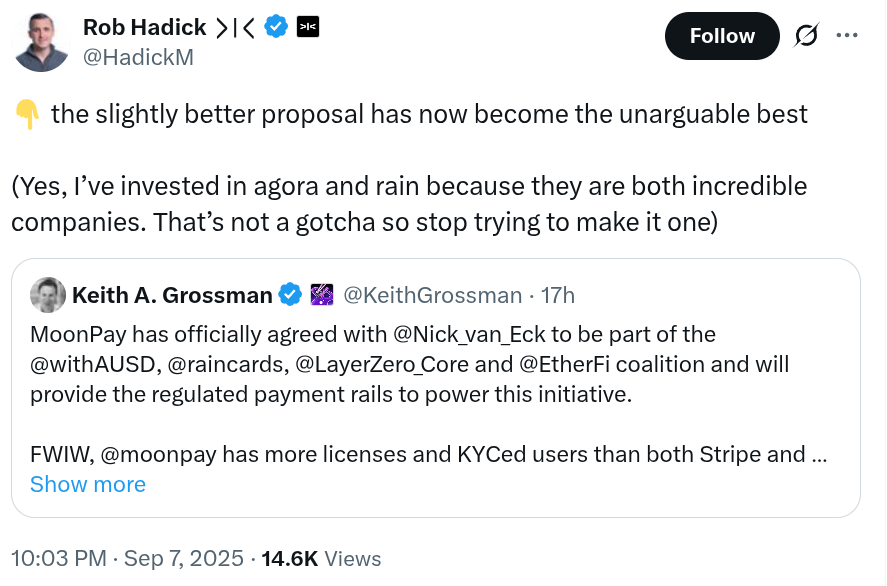The USDH stablecoin is now contested by Stripe’s Bridge, a MoonPay–Agora coalition, Paxos and Frax — each offering different reserve, governance and community-reward models. Hyperliquid will weigh compliance, reserve allocation and alignment with its Assistance Fund when selecting an issuer.
-
Multiple issuer proposals: Stripe (Bridge), MoonPay–Agora, Paxos and Frax are competing to issue USDH.
-
Proposals differ on reserve returns: some pledge community rewards, buybacks of HYPE or full earnings redistribution.
-
Stablecoin issuance decisions hinge on compliance, reserve transparency and ecosystem alignment; regulatory shifts are accelerating competition.
USDH stablecoin: Hyperliquid faces competing issuance bids from Stripe’s Bridge, MoonPay–Agora, Paxos and Frax — read the latest on proposals, reserves and governance.
What is the USDH stablecoin proposal?
USDH stablecoin is Hyperliquid’s proposed USD-pegged token intended to be “Hyperliquid-first, Hyperliquid-aligned, and compliant.” Multiple firms have submitted competing issuer proposals aiming to mint USDH and define reserve yields, governance alignment and community reward distributions.
How are issuers competing to issue USDH?
Stripe’s Bridge submitted a proposal via Native Markets to issue USDH and mint directly on the Hyperliquid ecosystem, promising regulatory compliance and reserve proceeds for the Assistance Fund. Competing proposals include:
- MoonPay–Agora coalition: offers regulated payment rails, prioritizes ecosystem alignment and community rewards.
- Paxos: proposes directing a share of reserve interest to buy back HYPE and distribute to users, validators and partners.
- Frax: pledges to return all earnings of USDH (backed by frxUSD) to the community.
Stakeholders are evaluating issuer experience, potential conflicts of interest (notably concerns about Stripe’s Tempo blockchain plans) and the structure of reserve yields or buyback mechanisms.
MoonPay, Agora, Paxos, Frax and others are challenging Stripe’s Bridge proposal to issue Hyperliquid’s USDH stablecoin, pushing for community rewards, buybacks and reserve-alignment options.
Stripe’s bid—submitted by the Native Markets team—proposed Bridge as issuer and pledged contributions from reserve proceeds to Hyperliquid’s Assistance Fund while minting directly on the network. The announcement prompted immediate pushback from several industry players.
Agora co-founder and CEO Nick Van Eck criticized the Stripe-linked option, citing conflict-of-interest risks and limited infrastructure depth. Van Eck warned that Stripe’s plans for its Tempo blockchain could shift activity away from Hyperliquid.
MoonPay president and board member Keyth Grossman joined Agora’s proposal, offering MoonPay’s regulated payment rails to support USDH issuance and emphasizing alignment with Hyperliquid’s objectives. Rob Hadick, general partner at Dragonfly.xyz, publicly endorsed the coalition after MoonPay’s inclusion.

Source: Rob Hadick
Paxos submitted an alternative that would allocate a percentage of reserve interest to buy back Hyperliquid’s HYPE token for redistribution to stakeholders. Frax offered a more radical community-first approach by pledging all earnings from USDH (backed by frxUSD) back to the ecosystem.
Why does USDH issuance matter to the stablecoin market?
USDH issuance matters because it illustrates how stablecoin design decisions shape incentives, custody models and regulatory exposure. As banks and institutions (notably HSBC and ICBC in Hong Kong) explore stablecoin licenses, issuer selection influences adoption, trust and cross-border utility.
Frequently Asked Questions
What regulatory signals are shaping this debate?
Jurisdictions are moving quickly: Hong Kong’s new framework and institutional interest, Kazakhstan’s acceptance of stablecoin fees, and regional projects like Wyoming’s Frontier Stable Token are expanding the policy landscape. Regulators’ focus on reserves, transparency and licensing raises the bar for issuers.
Key Takeaways
- Multiple bids: Stripe (Bridge), MoonPay–Agora, Paxos and Frax all seek to issue USDH.
- Different value models: Proposals promise Assistance Fund contributions, HYPE buybacks or full earnings redistribution.
- Decision factors: Compliance, reserve transparency, issuer experience and ecosystem alignment will determine the outcome.
Conclusion
The USDH stablecoin selection process highlights competing philosophies in stablecoin issuance: regulatory-first, market-capture or community-return models. Hyperliquid’s choice will shape token economics and ecosystem trust. Watch for Hyperliquid’s governance milestones and formal issuer-selection criteria in the coming weeks.
